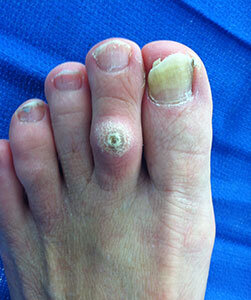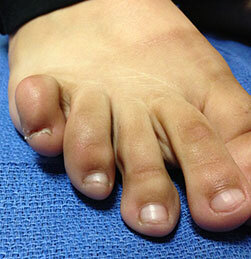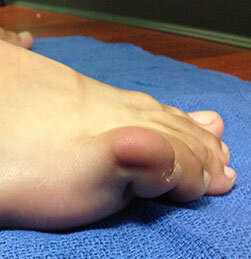Our Torrance, San Pedro & Los Angeles Foot Doctors Can Help With Your Hammertoe Treatment
HAMMERTOE
What is a Hammertoe? A normal toe is straight. A bent toe is called a hammertoe. There are two joints in every toe except the big toe which has one. When a toe contracts it often becomes stiff and bent at one or both joints. When the toe rubs in our shoes it may create a painful red spot or hard skin called a “corn” or “callus”.
What causes it? It is caused by a muscle imbalance where the tendons (attachments for muscles) are tighter on the bottom of the toe compared to the top of the toe. The deformity is commonly genetic but can be aggravated by tight fitting dress shoes.
What are my treatment options? Many patients will have significant improvement with special pads and shoes and this may be all one needs. However, when symptoms persist surgical repair is necessary. Unfortunately this deformity is often progressive with time and the toes will become more rigid and painful in the future.
At the Precision Foot and Ankle Centers, we encourage our patients to try different shoes and pads prior to having a procedure. If the toes hurt on a weekly basis then surgery is often necessary. The following is our treatment approach:
Step 1: Toe pads. Toe pads may include a hammertoe pad to help pull down the affected toe to be more even with the other digits. It may also include a crest-type pad which is placed under the affected toe to help straighten it. The most common pad we recommend is a silicone corn cushion. This pad is slipped over the affected toe and worn like a sock. It is important not to get these pads wet or they will not last very long. All of the pads are available in our office and can be ordered for you.
Step 2: Shoe Recommendations. Some shoes have more depth or width in the toe box. The most common brands that are known for this are New Balance, SAS, ECCO, Rockport, Munro’s, and Dansko. Some patients who are not good surgical candidates due to poor circulation or other medical problems may require a special order: Extra Depth Shoe.
Step 3: Spot Shoe Stretching. This can be performed only on a leather shoe, but most shoe repair places can do this for you. If you show them which toe is the problem they can use a device to stretch the leather specifically over the affected toe. Sometimes this is all one needs to alleviate their pain.
Step 4: Surgical Repair. Hammertoes are either flexible, semi-rigid or rigid. The longer you have had the deformity the more rigid it becomes. A flexible hammertoe can be treated with a soft tissue procedure, but a semi-rigid or rigid deformity requires a bone procedure.
When a bone procedure is necessary it usually includes removal of a section of bone over the affected joint or corn. Once the toe is realigned it is fused with the use of an absorbable or metallic pin. If the entire toe is dislocating above the other toes than a metallic pin is necessary to help prevent recurrence. The pin is usually removed in the office 4-6 weeks after surgery. If the 5th toe or “baby” toe is affected this toe does not need to be fused. In rare cases an implant or joint replacement is utilized for short toes.
The procedure is performed in a surgery center or hospital depending upon your insurance plan. It is performed under IV sedation by an anesthesiologist and local anesthesia. It typically takes 6 weeks for the toe(s) to heal. During this time you will need to wear a surgical shoe with Velcro straps for 3-6 weeks. You can walk with this, but if it is your right foot you will not be able to drive with it. Once you return to tennis shoes you will be able to drive with your right foot. Women may not return to a healed dress shoe for 2-4 months. You will not be able to perform cardiovascular exercise for 4-6 weeks.
There are risks with any type of foot surgery however this procedure has a very high success rate. Complications occur less than 10% of the time. The risks include infection, numbness, painful nerve, stiffness of the toe, an enlarged or painful scar, an elevated toe, a floppy toe and a shortened toe. In less than 5% of patients the toe may look great for more than a year, but then the toe tries to regenerate the bone that we removed. There is no way to predict this or prevent this but it rarely occurs. The most common risk or complication from this procedure is chronic swelling. This will not hurt you but it may limit you in the shoes you are able to wear. This occurs 20% of the time and in order to prevent this we ask you to wrap the toe(s) with coban or co-flex which is a self adherent wrap. You may need to wrap the toe for several months after the procedure to assist with the final healing. Most patients have very little discomfort after the first week and usually only need to take tylenol or advil for discomfort.
Please book an appointment with Precision Foot and Ankle Centers for a comprehensive evaluation.





